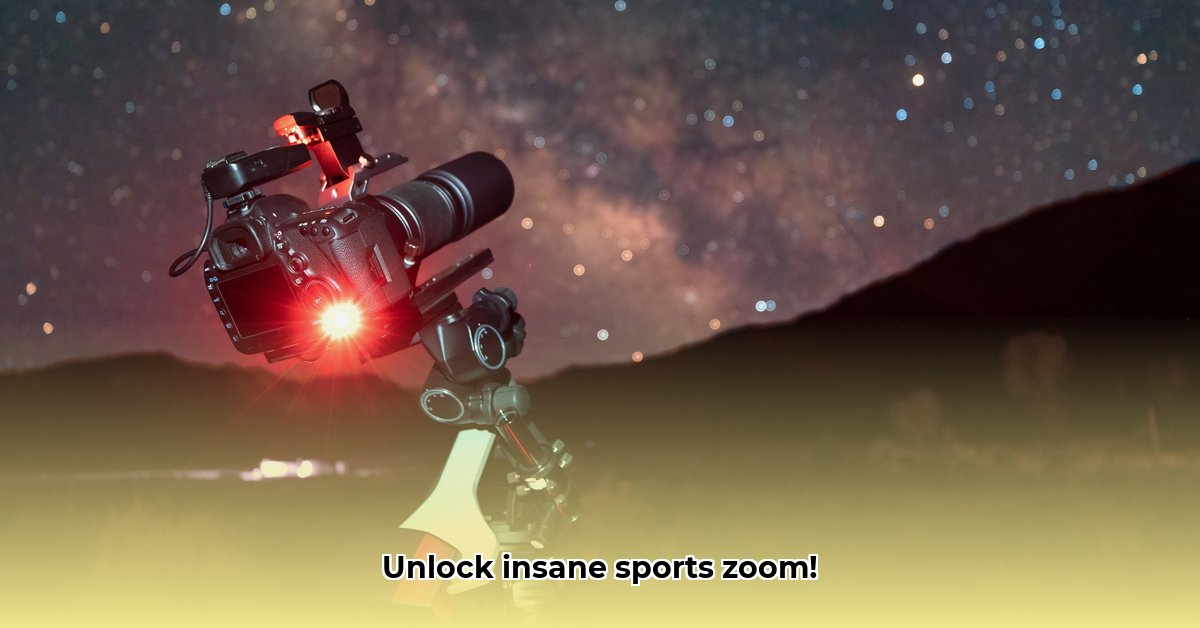
Maximum Zoom: Mastering Distance in Sports Photography
Capturing breathtaking sports moments often requires getting incredibly close to the action, even from a significant distance. Maximum zoom is your key to achieving this, bringing distant subjects into sharp focus. However, understanding the nuances of zoom is paramount to mastering this essential photographic technique.
Understanding Zoom: Optical vs. Digital
Maximum zoom isn't simply a single number; it represents your lens's ability to magnify distant subjects. Two key types exist: optical and digital. Optical zoom uses the lens's physical elements to magnify, resulting in high-quality images. It's analogous to using a telescope, genuinely enlarging the subject. Digital zoom, conversely, crops a portion of the image and enlarges it, sacrificing image quality for reach. The resulting image loses detail and can appear blurry. For sharp, professional sports photography, optical zoom is always preferred. Isn't image quality paramount in capturing those pivotal moments?
Factors Influencing Maximum Zoom Capability
Several factors dictate a lens's maximum zoom potential. Sensor size plays a crucial role. Larger sensors capture more light, improving image quality, particularly at higher zoom levels. However, larger sensors often require bigger, costlier lenses. The lens design is equally critical. Telephoto lenses, designed for long distances, offer far greater zoom than wide-angle lenses. Finally, increased zoom capability typically translates to both increased weight and cost. High-zoom lenses are often substantial and expensive.
Advantages of High Zoom
High-zoom lenses offer significant advantages in sports photography. Imagine capturing a golfer's focused expression before a crucial putt, the raw emotion on a player's face after scoring a goal, or the precise arc of a tennis serve – all from a comfortable distance. The creative potential is immense! High zoom allows the creation of visually striking, unique images encapsulating the action's essence – shots others simply can't achieve. Don't you want to capture those unique, decisive moments?
Disadvantages of Extreme Zoom
The power of high zoom comes with challenges. Image stabilization becomes crucial; even minor camera shake, amplified at maximum zoom, can lead to blurry images. The longer the zoom, the less light reaches the sensor, demanding faster shutter speeds and potentially higher ISO settings. Higher ISOs can introduce noise or graininess, negatively impacting image quality. Finally, ultra-high-zoom lenses are typically large, heavy, and costly.
Choosing and Using Your Equipment
Selecting the right equipment hinges on your budget, the specific sport, and your desired image quality. A football game requires different equipment than a golf tournament. Budget constraints might necessitate a versatile superzoom lens, offering a compromise between zoom range and affordability. While it might not match the maximum zoom of top-tier lenses, it presents a practical alternative. Professional sports photographers often invest in high-end lenses guaranteeing exceptional image quality and maximum zoom.
Optimal Settings for High-Zoom Photography/Videography
To avoid blurry photos at maximum zoom, mastering your camera settings is crucial. A fast shutter speed is essential to freeze action. Carefully manage your aperture: a narrower aperture (higher f-number) increases depth of field but reduces light intake. A wider aperture (lower f-number) lets in more light but decreases depth of field. Finding a balance is key. Consider your ISO: higher ISO permits faster shutter speeds in low light but increases image noise. Finally, precise focusing is essential. Employ single-point autofocus and lock onto your subject consistently.
Troubleshooting Common Issues
Even with optimal settings, challenges can arise. Image blur is common. Verify your shutter speed, ensure image stabilization is active (if available), and confirm correct autofocus settings. Low-light conditions necessitate increasing ISO, while being mindful of increased noise. Focusing difficulties can be overcome via single-point autofocus, carefully locking onto your subject.
Post-Processing Techniques
Even with perfect in-camera settings, post-processing significantly enhances images. Software like Adobe Photoshop or Lightroom helps sharpen details, reduce noise, and correct flaws, maximizing image quality. Even professionals rely on post-processing to refine high-zoom shots. Isn't it worth it?
Sample Lens Recommendations
The following table provides examples of lens types suitable for different sports, indicating approximate maximum zoom ranges. Note that exact specifications vary based on the specific lens model.
| Sport | Lens Type | Approximate Maximum Zoom (mm) | Considerations |
|---|---|---|---|
| Football | Super Telephoto Zoom | 600mm - 800mm | Needs strong image stabilization; substantial weight |
| Golf | Telephoto Prime | 200mm - 400mm | Sharper images due to simpler design; ideal for detail capture |
| Motorsports | Super Telephoto Zoom | 1000mm + | Exceptional reach, but very expensive and bulky |
Mastering maximum zoom requires practice and patience. Use this guide as your starting point, experiment, learn from your mistakes, and enjoy capturing stunning sports images from any distance!
⭐⭐⭐⭐☆ (4.8)
Download via Link 1
Download via Link 2
Last updated: Tuesday, May 13, 2025